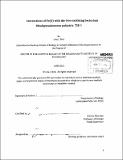Interactions of Fe(II) with the iron oxidizing bacterium Rhodopseudomonas palustris TIE-1
Author(s)
Bird, Lina J. (Lina Joana)
DownloadFull printable version (10.61Mb)
Alternative title
Positive and negative effects of Fe(II) on photoferrotroph Rhodopseudomonas palustris TIE-1 under anoxic conditions
Other Contributors
Massachusetts Institute of Technology. Department of Biology.
Advisor
Dianne Newman.
Terms of use
Metadata
Show full item recordAbstract
Microbial anaerobic iron oxidation has long been of interest to biologists and geologists, both as a possible mechanism for the creation of banded iron formations before the rise of oxygen, and as a model system for organisms able to accept electrons from an external, inorganic source. Previous work with the purple photoferrotroph Rhodopseudomonas palustris TIE-1 showed that three genes were required for phototrophic growth with Fe(Il): PioA, a decaheme cytochrome, PioB, an outer membrane porin, and PioC, a high potential iron protein (HiPIP). These proteins suggested a model of Fe(II) oxidation that ends with transfer of electrons to the photosynthetic reaction center. The goal of this thesis was to test and extend this model through characterization of the electron transfer proteins PioA and PioC. In the course of our experiments, we discovered that Fe(II) could also delay growth under certain conditions. We then broadened our focus to encompass several facets of the interaction of TIE-1 with Fe(II) under anaerobic conditions: The first portion describes how low amounts of Fe(II) cause a growth delay in TIE-1 cultures growing anaerobically on other substrates - a surprising result for an organism that grows on millimolar concentrations of iron. The cause of this toxicity was found to be dependent on copper, which is toxic to TIE-i at fairly low concentrations. Our results indicate the copper toxicity is synergistically increased by Fe(II) under strictly anaerobic conditions. The second part of this work describes characterization of the HiPIP PioC and a second HiPIP in the TIE-1 genome. The results showed that PioC is capable of reducing the reaction center, as expected, though at a slower rate than is usually found for this kind of interaction. The second HiPIP cannot reduce the reaction center and likely serves an alternate function in the cell unrelated to photosynthesis, possibly involving detoxification of metals. The final section redefines our understanding of the Fe(II) oxidation pathway by putting it in the context of reverse electron transfer, a process that is not well understood in photosynthetic bacteria. Evidence from whole cell experiments using flash induced spectrometry indicated that electrons from Fe(II) may, rather than going to the reaction center, enter the quinone pool through the bc1 complex. This model is significantly different from previous preferred models of phototrophic oxidation, but is similar to the reverse electron transfer system described in acidophilic lithotrophic iron oxidizing bacteria. Taken together, the experiments described in this thesis highlight the complex and interconnected nature of a bacterial cell's interactions with iron under anoxic conditions. It also suggests future avenues of study for phototrophic reverse electron transfer, a poorly understood process that is vital to anoxygenic photoautotrophic growth.
Description
Thesis (Ph. D.)--Massachusetts Institute of Technology, Dept. of Biology, June 2013. "June 2013." Cataloged from PDF version of thesis. Includes bibliographical references.
Date issued
2013Department
Massachusetts Institute of Technology. Department of BiologyPublisher
Massachusetts Institute of Technology
Keywords
Biology.